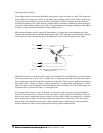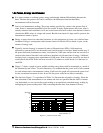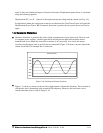
1.2:
Power,
Energy
and
Demand
Q
It is quite common to exchange power, energy and demand without differentiating between the
three. Because this practice can lead to confusion, the differences between these three
measurements will be discussed.
Q
Power is an instantaneous reading. The power reading provided by a meter is the present flow of
watts. Power is measured immediately just like current. In many digital meters, the power value is
actually measured and calculated over a one second interval because it takes some amount of time to
calculate the RMS values of voltage and current. But this time interval is kept small to preserve the
instantaneous nature of power.
Q
Energy is always based on some time increment; it is the integration of power over a defined time
increment. Energy is an important value because almost all electric bills are based, in part, on the
amount of energy used.
Q
Typically, electrical energy is measured in units of kilowatt-hours (kWh). A kilowatt-hour
represents a constant load of one thousand watts (one kilowatt) for one hour. Stated another way, if
the power delivered (instantaneous watts) is measured as 1,000 watts and the load was served for a
one hour time interval then the load would have absorbed one kilowatt-hour of energy. A different
load may have a constant power requirement of 4,000 watts. If the load were served for one hour it
would absorb four kWh. If the load were served for 15 minutes it would absorb ¼ of that total or
one kWh.
Q
Figure 1.7 shows a graph of power and the resulting energy that would be transmitted as a result of
the illustrated power values. For this illustration, it is assumed that the power level is held constant
for each minute when a measurement is taken. Each bar in the graph will represent the power load
for the one-minute increment of time. In real life the power value moves almost constantly.
Q
The data from Figure 1.7 is reproduced in Table 2 to illustrate the calculation of energy. Since the
time increment of the measurement is one minute and since we specified that the load is constant
over that minute, we can convert the power reading to an equivalent consumed energy reading by
multiplying the power reading times 1/60 (converting the time base from minutes to hours).
Electro Industries/GaugeTech
Doc # E107706 V1.25 1-6
Time (minutes) Æ
Kilowatts
20
40
60
80
100
Figure 1.7: Power Use Over Time


















